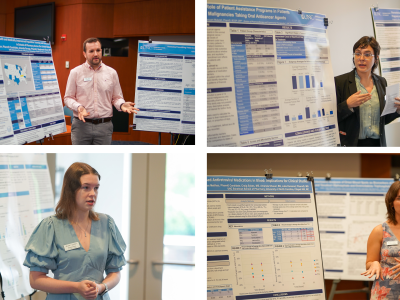December 12, 2014
Two researchers from the UNC Eshelman School of Pharmacy at the University of North Carolina at Chapel Hill have received a $1.6 million grant to estimate and map the health literacy of neighborhoods across America.
The team plans to use the project to examine health literacy’s effect on hospital readmission rates. Hospitals are penalized by the Centers for Medicaid and Medicare Services if patients who come in for certain conditions return to the hospital within thirty days after discharge.
 Hospitals Unfairly Penalized?
Hospitals Unfairly Penalized?
Stacy Bailey, PhD, MPH, and Gang Fang, PharmD, PhD, will use the four-year grant from the National Institute on Aging to estimate the health-literacy level of every census block group in the nation. There are more than 200,000 census block groups in the United States.
“Just by knowing someone’s address, we will be able to estimate their health literacy,” Bailey says.
Health literacy is the ability to process and understand the information needed to make health decisions. Adults with poor health literacy are 42 percent more likely to report their health as poor than adults with proficient health literacy, according to the U.S. Department of Health and Human Services. Download Quick Guide to Health Literacy.
The current formula for penalizing hospitals for high readmission rates accounts for things like patient age and severity of illness but does not factor in health literacy despite the fact that poor health literacy is associated with higher readmission rates, Fang says.
“We will look to see if the penalties would change if you adjusted the model to include the health-literacy levels of the patients being served,” he says.
Health Literacy
Almost half of American adults have difficulty understanding and using health information, according to the Institute of Medicine.
“Health literacy is affected by education, familiarity with the health-care system, and a person’s cognitive and social skills, along with a number of socio-economic factors. They are all linked,” Bailey says.
Bailey and Fang say they hope to have their map of health literacy available to the public by the end of 2015. Having the health literacy estimates will allow researchers to examine the relationship between health literacy and health outcomes on a larger scale than previously possible with direct assessments of literacy.
“We will link our health-literacy estimates to large Medicare data sets to analyze a number of health outcomes on an unprecedented scale,” Bailey says. “This will not only help advance the field of health literacy but hopefully also inform health-care policy.”
Bailey and Fang are assistant professors in the School’s Division of Pharmaceutical Outcomes and Policy.
Latest News

Dean Angela Kashuba receives Carolina Alumni Faculty Service Award

RASP poster presentations capture student research


